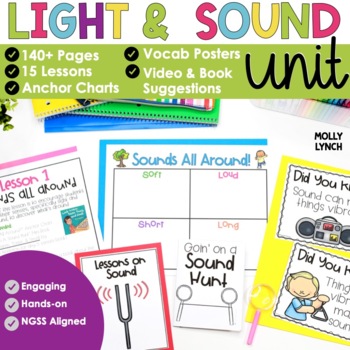Science: Light & Sound Lessons, Experiments & Activities 1st Grade Science NGSS
- Zip
What educators are saying
Also included in
- Your 1st grade scientists will be on the edge of their seats to learn the Next Generation Science Standards Unit with these highly engaging, hands-on, easy-to-understand Science lessons for the first grade NGSS!With over 500 pages, you can easily and confidently teach your first graders the importanPrice $60.00Original Price $75.00Save $15.00
Description
Your little 1st grade scientists will be on the edge of their seat with this Next Generation Science Standards Unit that teaches them that Light & Sound are forms of Energy. Your students will love learning about and experimenting with sound vibrations, light refraction and more!
This 140+ page resource will make teaching science a breeze. Complete with step-by-step lesson plans, experiments, activities...and so much more. This hands-on unit has everything you need to get your students interacting and exploring Light & Sound.
✨Resource Includes: 140+ pages
- Step-by-Step Lesson Plans
- Hands-on Experiments & Investigations
- Anchor Charts
- Follow Up Activities (Check for Understanding)
- Response Sheets
- Book Suggestions
- Video Titles & Links
- Background Information on Light & Sound (in easy to understand terms)
- Materials List (most objects are readily available in your classroom, the dollar store, or through donations)
- Parent Letter
- PowerPoint Game
✨ Lessons Included:
Intro: What is a Scientist?
Lessons on Sound
- Lesson 1: Sounds All Around
- Lesson 2: What’s That Sound?
- Lesson 3: Good Vibrations
- Lesson 4: Makin’ Music
- Lesson 5: Sound on the Move
- Lesson 6: Sounds Like to Move It! Move it!
Lessons on Light
Lesson 1: Do You See What I See?
- Lesson 2: Is it Real or Artificial? + PowerPoint Game
- Lesson 3: Let There Be Light!
- Lesson 4: Eye Tricks
- Lesson 5: Mirror! Mirror!
- Lesson 6: Seeing Shadows
Lessons on Communication
- Lesson 1: Can You Hear Me Now?
- Lesson 2: What’s That, You Say?
Slainte,
☘️ Molly
Lucky Learning with Molly Lynch
Looking for more great products?
⭐ Structure, Function, and Information Science for 1st Grade NGSS
⭐ Learn About the Seven Continents
⭐ A Year of Early Finishers Books - Activities for Early Finishers!
Connect with Lucky Learning with Molly Lynch:
Be the first to know about my new discounts, freebies, and product launches






